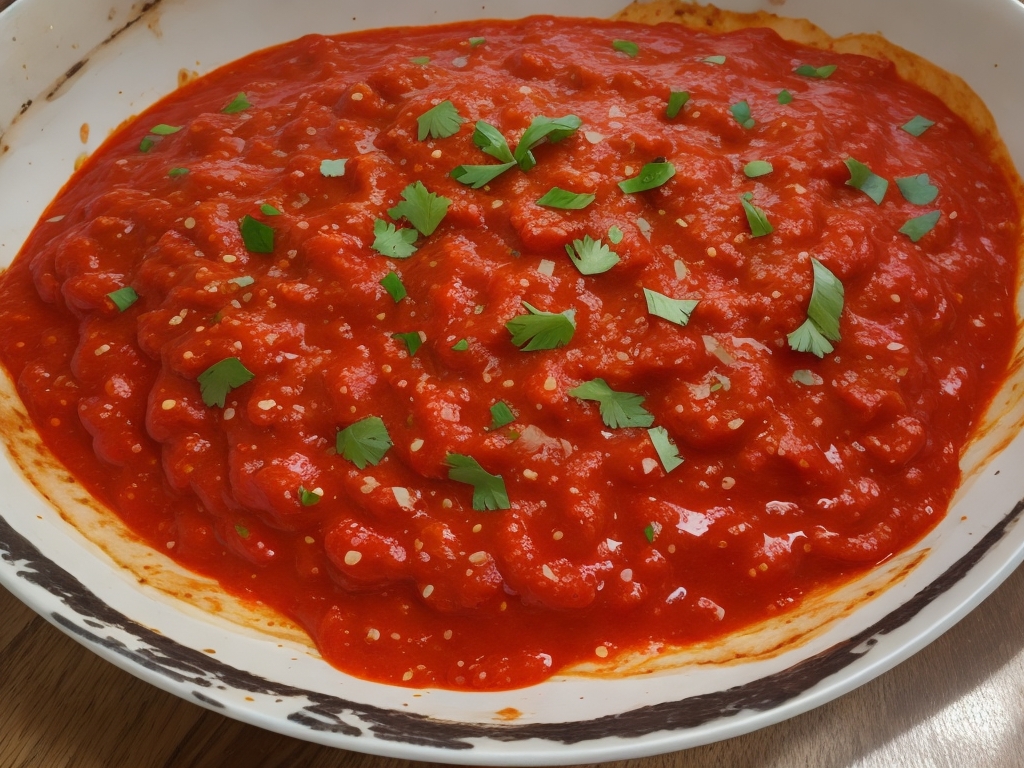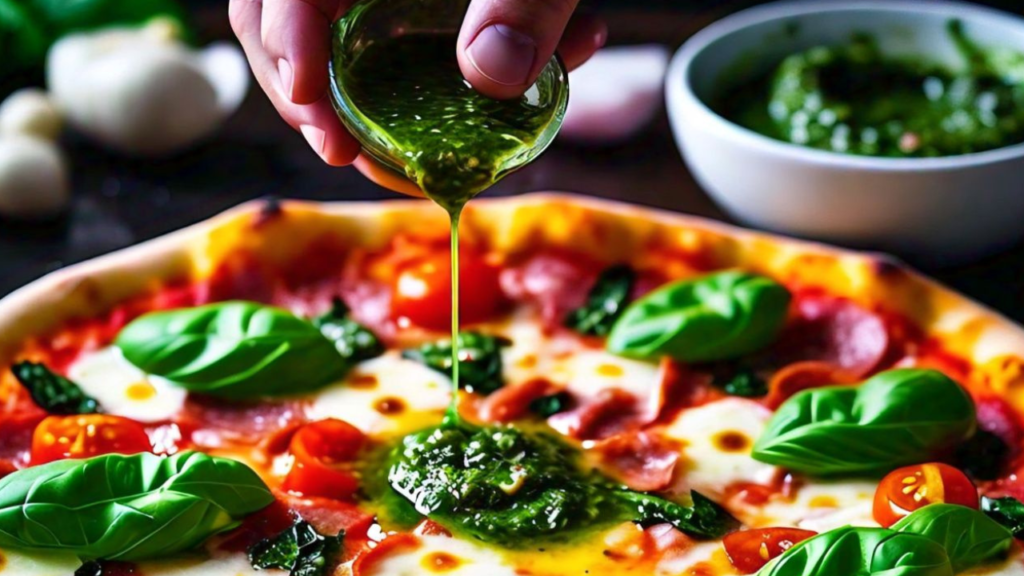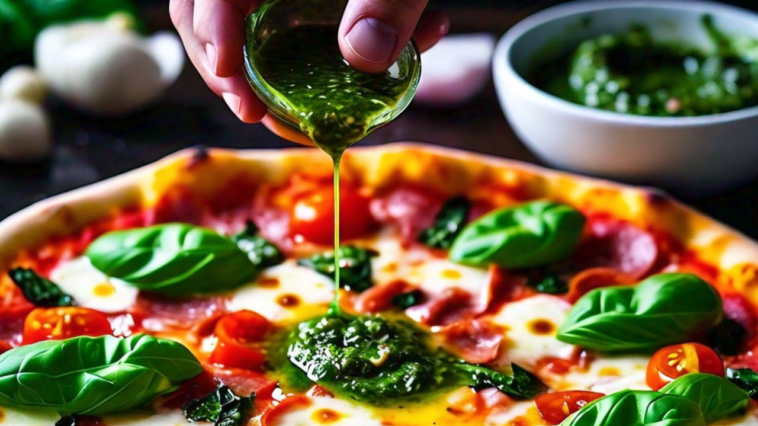The combination of a well-prepared pizza dough with fresh, flavorful toppings is simply unmatched. This recipe for Pizza Dough recipe Using 00 Flour, Whole Tomatoes, and Chimichurri delivers a smooth texture, ideal for crafting a pizza crust that is both crispy and soft. The chimichurri sauce adds a vibrant, herbaceous kick, while the sweet tomatoes provide a juicy burst of flavor.
Creating the perfect pizza at home requires both artistry and precision. Using high-quality ingredients like whole tomatoes, 00 flour, and fresh chimichurri transforms your pizza from ordinary to extraordinary. In this guide, we’ll walk you through each step so that your homemade Pizza Dough Using 00 Flour, Whole Tomatoes, and Chimichurri is not only delicious but also easy to make.
While you can certainly make this authentic Italian pizza dough by hand, using a mixer simplifies the process. No need for tossing—this method is fail-proof. In fact, this recipe is the reason I invested in a mixer and a pizza stone.
After visiting Italy in search of the perfect rustic Italian pizza dough and experimenting with various techniques, I am convinced this is the best recipe out there.
Why Use 00 Flour?
The crust is the backbone of a truly exceptional pizza. For an authentic Neapolitan-style pizza crust, nothing compares to 00 flour. This premium flour, finely milled to perfection, yields a crust that’s both crispy and tender.
What is 00 Flour?
This premium Italian flour, Caputo “00”, is finely ground and ideal for traditional pizza and pasta dishes. Its lower protein content compared to bread flour results in a more flexible dough that is less likely to develop too much gluten. The result is a light, airy pizza crust that bakes quickly in a hot oven.
The Magic of Whole Tomatoes
The quality of your tomatoes makes all the difference in pizza sauce. While many recipes use crushed or canned tomatoes, we recommend using whole tomatoes for a fresher, richer flavor.
Why Choose Whole Tomatoes?
San Marzano and Roma tomatoes, renowned for their rich flavor, boast low acidity and a hint of natural sweetness. Hand-crushing them allows you to retain more of their natural juices and flavors, creating a sauce that is both robust and delicate.
Making Your Tomato Sauce.
- Begin with a can of whole tomatoes, peeled for convenience.
- Drain the excess juice (but save it for another use—it’s delicious!).
- In a bowl, hand-crush the tomatoes until they are slightly chunky for texture.
- Elevate with fresh basil, salt, and a touch of warm honey for a balanced taste.

This simple sauce enhances the tomato flavor without overwhelming the crust.
Adding Chimichurri to Your Pizza
Chimichurri, a vibrant Argentinean sauce made with fresh herbs, garlic, vinegar, and oil, adds an unexpected burst of flavor to pizza. Typically used as a condiment for grilled meats, chimichurri’s tangy, herbaceous notes make it a fantastic pizza topping.
How to Make Chimichurri.
- In a food processor, combine fresh parsley, garlic, oregano, and red chili flakes.
- Pulse in olive oil and red wine vinegar until the mixture reaches a coarse chop, avoiding pureeing.
- Check the flavor and add salt and pepper as needed to perfect the seasoning.

Depending on your preference, you can drizzle this sauce over the pizza before or after baking. You can also swirl it into your tomato sauce or use it as a base, adding your other toppings for a more integrated flavor.

Step-by-Step Pizza Dough Recipe Ingredients:
Ingredients
- 500g 00 flour
- 325ml water
- 10g sea salt
- 3g fresh yeast, or 1g active dry yeast
- 1 tsp olive oil
Instructions.
- Dissolve the yeast in water in a large bowl. Gradually add the 00 flour, mixing until a shaggy dough forms. Let it rest for ten minutes to allow the flour to hydrate.
- Turn the dough out onto a floured surface and knead for 10-15 minutes, until it develops a smooth, elastic texture and a subtle stickiness. Adjust the flour content if necessary.
- Put the dough in a bowl coated with a thin layer of oil, cover it with a damp cloth, Let it rise in a warm, draft-free space at room temperature for 1-2 hours, or until it has expanded to twice its original size.
- After the dough has risen, move it to a floured surface and split it into 2-4 equal pieces, depending on the size of pizza you prefer. Create a compact, rounded shape with each piece and let them sit for 20 minutes.
- Set your oven to its highest heat setting (around 250°C or 482°F) and, if you’re using a pizza stone, put it in the oven to warm up with the oven. Roll or stretch each dough ball into a thin circle, about 12 inches in diameter.
- Spread a thin layer of your hand-crushed tomato sauce over the dough, leaving a small border for the crust. Add your favorite toppings, but be careful not to overload the pizza—less is often more.
- Transfer the pizza to the preheated stone or baking tray and bake for 7-10 minutes, or until the cheese is bubbling and the crust is golden. If desired, drizzle chimichurri over the pizza before serving.
Different Types of Pizza Ovens
The outcome of your pizza is greatly influenced by the type of oven you use. Here’s a breakdown of different pizza ovens and their impact on your homemade pizza:
Wood-Fired Ovens.
- The gold standard in pizza-making, wood-fired ovens can reach temperatures as high as 900°F, cooking pizzas in under 90 seconds. The high heat and smoky flavor combine to give the pizza a singular taste and texture that’s hard to match with other types of ovens.
Gas Pizza Ovens.
- While not as hot as wood-fired ovens, gas pizza ovens are more convenient and can still reach high temperatures. They offer a more budget-friendly option and are simpler to operate.
Electric Pizza Ovens.
- Popular for home use, electric pizza ovens are compact and easy to operate. Although they don’t reach the high temperatures of gas or wood-fired ovens, they can still produce good results with the right technique.
Tips for Perfecting Your Pizza Crust
Invest in a Pizza Stone or Steel.
- A pizza stone or steel can simulate the conditions of a pizza oven, absorbing and retaining heat for a crispy crust. This is essential for creating a crispy bottom crust.
Preheat Your Oven.
- Always preheat your oven for at least 30 minutes to ensure it’s hot enough to bake the pizza quickly and evenly. Insert a pizza stone or steel into the oven as it preheats.
Don’t Overload with Toppings.
- Resist the urge to overload on toppings, as this can lead to a soggy pizza. Stick to a few well-chosen ingredients so the crust bakes properly.
Experiment with Hydration Levels.
- Adjusting the hydration level—the water content in the dough—will change the texture of your crust. Doughs with lower hydration levels result in a denser, chewier texture, whereas higher hydration levels yield a lighter, airier crust.
Cold Ferment for Enhanced Flavor.
- Allowing your dough to cold ferment in the refrigerator for 24-72 hours will improve its flavor and texture. The longer fermentation time allows the yeast to work more slowly, developing complex flavors.
Topping Ideas
Pizza is all about customization, so feel free to experiment with different toppings to create your signature pizza. Here are some models.
Classic Margherita.
- Experience the authentic taste of Italy with a topping of fresh mozzarella, hand-crushed tomatoes, and delicate basil leaves. Serve with a light drizzle of extra virgin olive oil added at the last moment.
BBQ Chicken Pizza.
- Combine shredded chicken, thinly sliced red onions, and a tangy BBQ sauce drizzle for a savory and sweet topping. Incorporate smoked gouda or cheddar to infuse a rich, smoky taste.
Vegetarian Delight.
- Load up on colorful vegetables like bell peppers, red onions, zucchini, and spinach. Finish with feta cheese and oregano.
Meat Lovers.
- Pile on pepperoni, sausage, bacon, and ham. Complete your dish with a layer of melted mozzarella and a pinch of red pepper flakes for an extra burst of flavor.
FAQs
Q1. What is 00 flour and why is it used in pizza dough?
- 00 flour is a finely milled wheat flour traditionally used in Italian pizza recipes. It creates a soft, elastic dough that is perfect for making a thin, crispy Neapolitan-style pizza crust.
Q2. Can I substitute regular flour for 00 flour?
- While you can use all-purpose or bread flour, 00 flour is recommended for its superior texture and ability to create a lighter, more authentic pizza crust.
Q3. Why should I use whole tomatoes for my pizza sauce?
- Whole tomatoes, particularly San Marzano or Roma varieties, offer a fresher, richer flavor compared to crushed or canned tomatoes. They balance sweetness with low acidity, enhancing the overall taste of your pizza.
Q4. What is chimichurri and how does it enhance pizza?
- Chimichurri is a classic Argentinean sauce blending fresh herbs, garlic, vinegar, and oil. It adds a bright, tangy flavor and a unique twist to traditional pizza toppings.
Q5. Can I make the pizza dough ahead of time?
- To achieve optimal flavor and texture, prepare the pizza dough ahead of time and let it cold ferment in the refrigerator for 24-72 hours.
Q6. What kind of oven is best for baking pizza?
- Pizza is best baked in a wood-fired oven, which reaches extremely high temperatures, often up to 900°F (482°C). These high temperatures cook the pizza quickly, typically in 90 seconds or less, resulting in a perfectly crispy crust with a slightly charred exterior and a soft, chewy interior. The powerful heat evenly melts the cheese and elevates the flavors of the toppings, resulting in a deliciously balanced pizza.
- The wood-fired oven’s unique smoky flavor adds an extra layer of depth and authenticity to the pizza, making it a favorite among pizza enthusiasts. While wood-fired ovens are considered the gold standard for pizza making, they do require outdoor space, a significant time investment to heat up, and a larger financial commitment.
- When a wood-fired oven isn’t available, gas pizza ovens are a great backup option. They are capable of reaching high heat levels, nearly matching the intense temperatures of wood-fired ovens. Gas ovens provide greater convenience and precision, with easy-to-control temperature settings for consistent results. Not only that, but they are also usually more economical and require less effort to maintain.
- Electric pizza ovens, while not as powerful as wood or gas-fired options, are popular for home use due to their compact size and ease of operation. With the right technique, they can still produce excellent pizzas, though they typically require longer cooking times and may not achieve the same level of crust crispiness.
- For those using a standard home oven, a pizza stone or steel can help replicate some of the effects of a professional pizza oven by retaining heat and ensuring even cooking. For a superior homemade pizza, preheat the stone or steel in the oven for at least 30 minutes to achieve optimal results.




